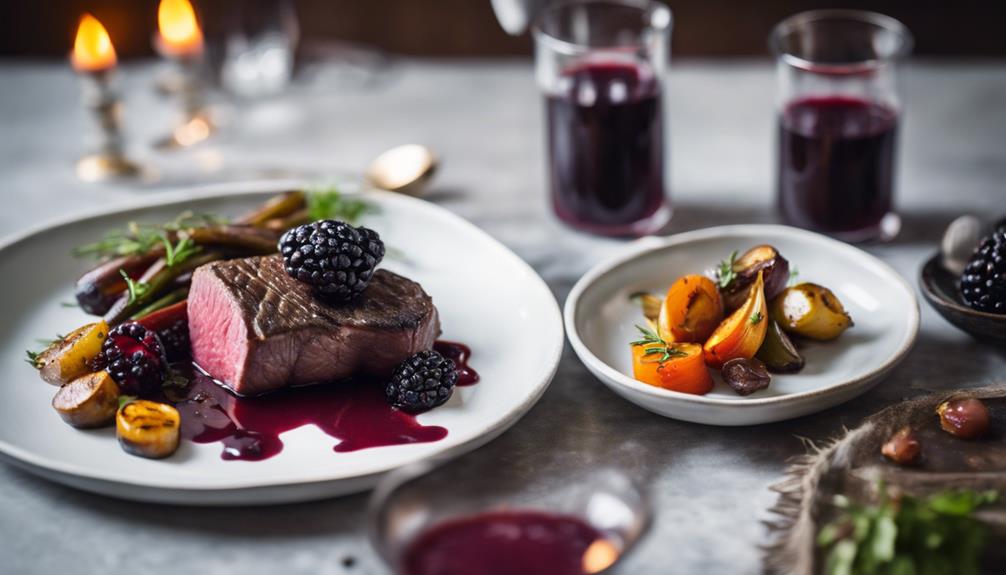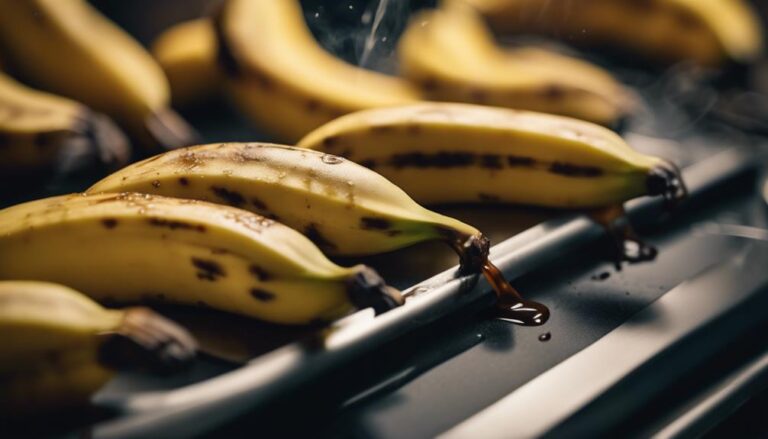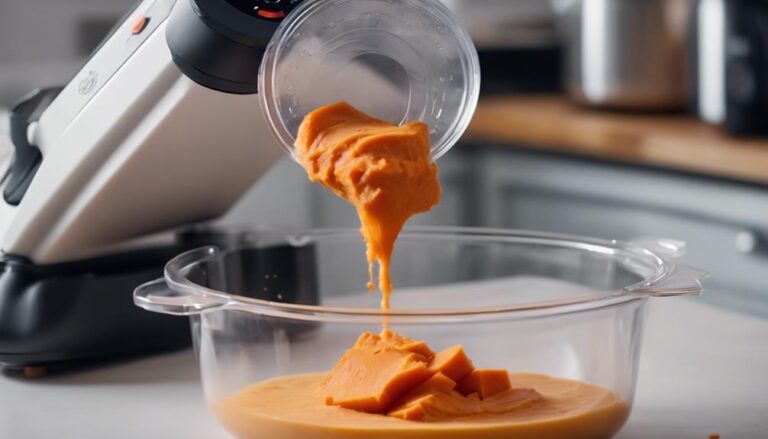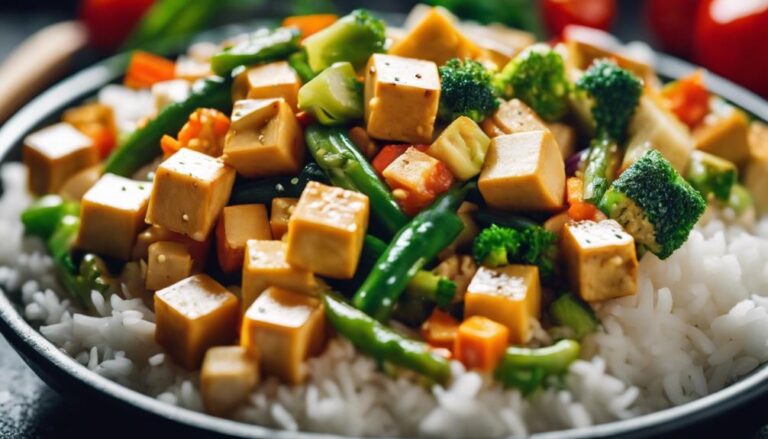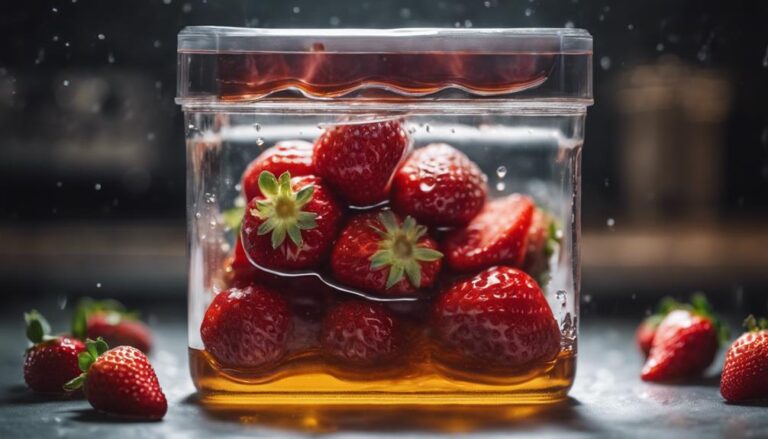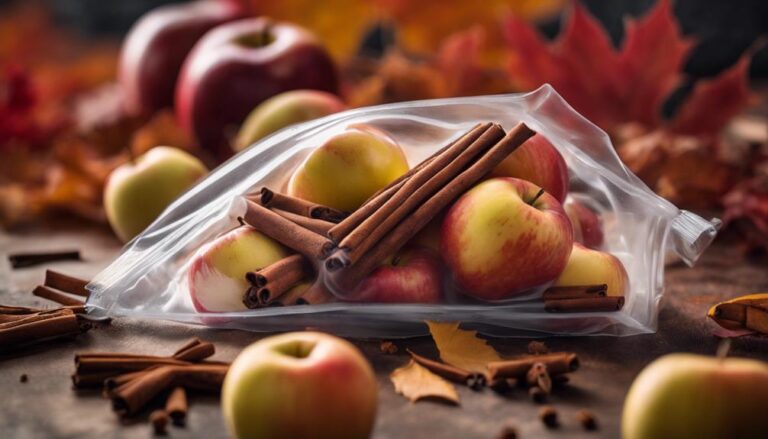Sous Vide Venison With Blackberry Compote
For a succulent dish, try sous vide venison with blackberry compote. Seal in flavors with precision cooking, ensuring tender meat. The contrast of sweet blackberry compote enhances the savory venison. You'll enjoy a burst of flavors that elevate this dish to new heights.
What You Will Learn Here
- Sous vide ensures precise cooking for tender venison
- Slow cooking method enhances meat's texture and flavor
- Blackberry compote adds contrasting sweetness to dish
- Pairing creates a unique and sophisticated flavor profile
- Blackberry infusion elevates the overall dining experience
Venison's French Culinary Roots
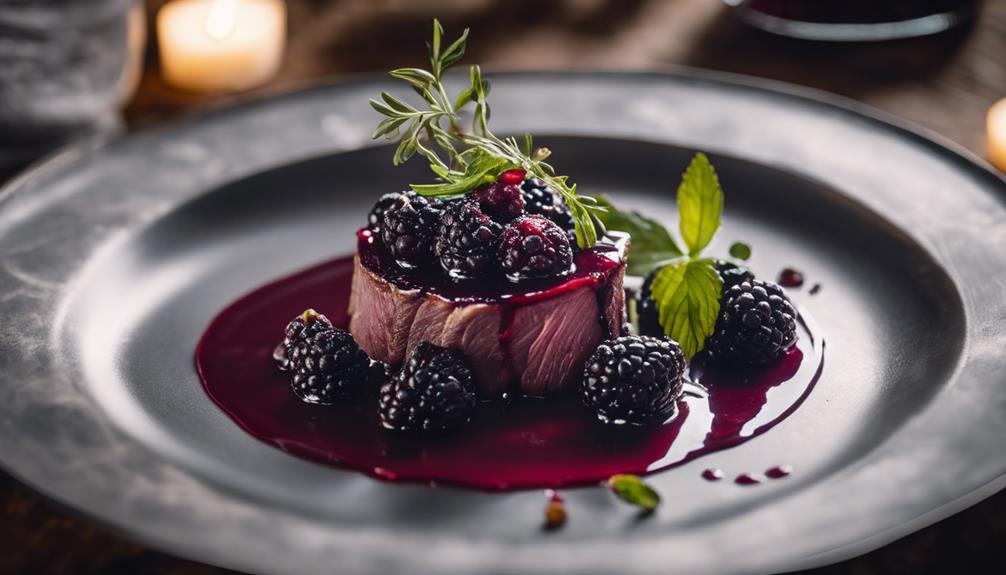
French venison history traces back to the culinary influence of France, where the origins of preparing this game meat can be found. Venison holds a significant place in French cuisine, with traditional recipes showcasing the delicate flavors and textures of this lean meat.
Exploring the French roots of venison offers insight into the rich history and culinary techniques that have shaped its preparation over the centuries.
French Venison History
Discover the rich culinary heritage behind venison in France by exploring its historical roots. French venison history dates back centuries, where venison, particularly from deer and wild boar, held a significant place in the country's culinary traditions. In medieval times, venison was a prized meat served in royal feasts and noble banquets, symbolizing wealth and luxury.
French aristocrats often enjoyed venison prepared in elaborate dishes, showcasing the culinary skills of the royal chefs. The flavors of venison were enhanced with aromatic herbs and spices, reflecting the sophistication of French gastronomy.
As hunting was a popular pastime among the French nobility, venison became a staple in their diet. The hunting season provided ample opportunities to procure fresh venison, which was then expertly prepared to create delectable dishes fit for royalty.
Over the years, French venison dishes have evolved, blending traditional recipes with modern cooking techniques. The historical significance of venison in French cuisine continues to influence contemporary culinary practices, making it a beloved and enduring part of the country's gastronomic heritage.
Culinary Influence Origins
Venture into the culinary origins of venison in France by tracing back to the historical influences that shaped its esteemed place in French gastronomy. Venison, a term derived from the Latin word 'venari,' meaning to hunt, has deep roots in French culinary history. The tradition of hunting game meat, including venison, dates back centuries in France, where it was considered a prized delicacy among the nobility.
French cuisine has long been associated with sophistication and culinary excellence, and venison played a significant role in shaping this reputation. The French aristocracy's fondness for hunting and feasting on wild game, such as venison, influenced the development of elaborate cooking techniques and flavor profiles that are still celebrated today.
The French approach to preparing venison often involves marinating the meat in rich red wine and aromatic herbs, enhancing its natural flavors and tenderizing the meat. This method of preparation reflects the French culinary philosophy of using quality ingredients and intricate cooking methods to create exquisite dishes. The influence of French culinary traditions on venison preparation has transcended borders, making it a beloved choice for gourmet dishes worldwide.
Venison in French Cuisine
Exploring the historical origins of venison in French cuisine reveals a rich tapestry of culinary traditions and influences. French cuisine has a long-standing relationship with venison, dating back centuries. Venison, which refers to the meat of deer, has been a prominent feature in French gastronomy due to the country's rich hunting culture and abundant deer population. The French have a deep appreciation for game meats, including venison, which is often celebrated for its lean yet flavorful profile.
In French cuisine, venison is commonly prepared in various ways to highlight its natural taste and tenderness. Traditional French dishes featuring venison include venison stew, venison steaks, and venison roasts, often accompanied by rich sauces and seasonal ingredients. French chefs have mastered the art of cooking venison to perfection, creating dishes that showcase the meat's unique flavors while complementing it with sophisticated culinary techniques.
French culinary roots have greatly influenced the preparation and presentation of venison dishes worldwide, showcasing the elegance and refinement that define French cooking. The incorporation of venison in French cuisine reflects a harmonious blend of tradition, innovation, and culinary excellence.
Venison Marinade Components
For a flavorful marinade for your venison, combine red wine, garlic, rosemary, and olive oil in a bowl.
- Red Wine: Red wine not only adds depth of flavor but also helps tenderize the venison, making it more succulent.
- Garlic: Garlic provides a pungent kick that complements the rich gamey taste of venison.
- Rosemary: Rosemary's earthy and pine-like flavor enhances the overall aroma of the meat.
- Olive Oil: Olive oil helps coat the venison, locking in moisture during the cooking process.
Marinating your venison with this combination of ingredients won't only infuse it with a delicious taste but also help tenderize the meat, ensuring a juicy and flavorful outcome.
Remember to let the venison marinate for at least a few hours, or ideally overnight, to allow the flavors to fully penetrate the meat. The red wine adds acidity and helps break down the proteins in the venison, resulting in a more tender texture. Garlic and rosemary bring a savory depth that complements the natural flavors of the venison, while the olive oil helps seal in moisture and create a beautiful crust when seared.
This marinade is a simple yet effective way to elevate the taste of your venison dish.
Delectable Venison Dishes
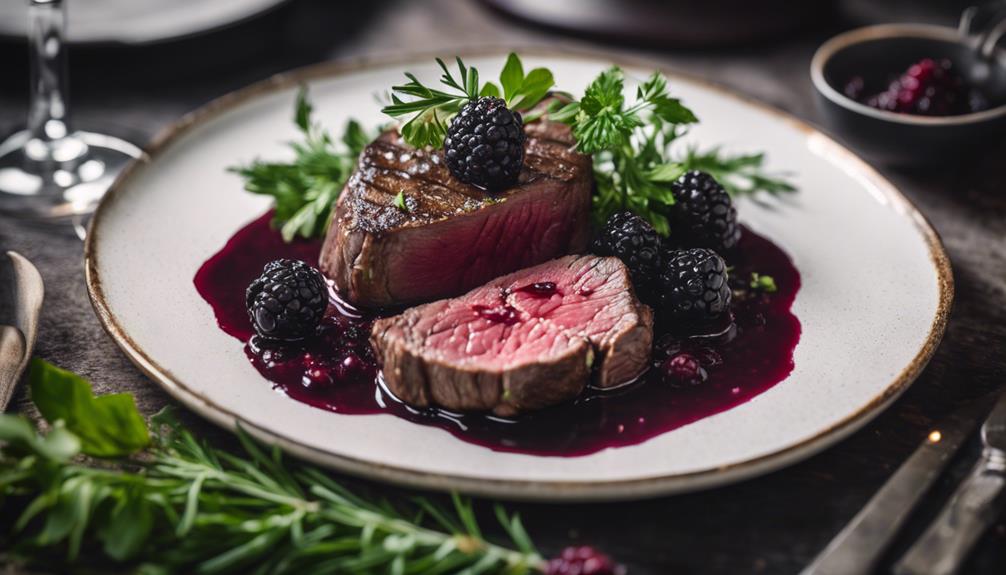
If you're craving a taste of the wild, try whipping up Succulent Venison Medallions, the perfect dish for showcasing the rich flavors of venison.
For a more sophisticated option, consider Blackberry-Glazed Venison Loin, a sweet and savory delight that's sure to impress your dinner guests.
And if you're in the mood for a comforting meal, don't miss out on the hearty Venison Stew With Red Wine, a classic dish that will warm both your heart and your belly.
Succulent Venison Medallions Recipe
Have you ever experienced the succulent tenderness of venison medallions cooked to perfection? Venison medallions are a delectable dish that can elevate your culinary skills. Here are some tips to help you create succulent venison medallions:
- Choose Quality Venison: Opt for fresh, high-quality venison to guarantee a flavorful outcome.
- Proper Seasoning: Season the medallions with a balanced blend of herbs and spices to enhance the natural taste of the meat.
- Precise Cooking Time: Cook the venison to the perfect doneness by following precise cooking times to achieve a tender texture.
- Resting Period: Allow the venison to rest after cooking to let the juices redistribute, resulting in a moist and juicy medallion.
Blackberry-Glazed Venison Loin
Indulge in the tantalizing flavors of Blackberry-Glazed Venison Loin, a dish that promises a harmonious blend of sweet and savory notes. This exquisite recipe will elevate your culinary skills and impress your guests with its delectable taste.
Here are some key points to keep in mind when preparing this mouthwatering dish:
- Tender Venison Loin: Guarantee your venison loin is of high quality and trimmed to perfection for a melt-in-your-mouth experience.
- Homemade Blackberry Glaze: Create a luscious blackberry glaze by simmering fresh blackberries with a hint of honey and balsamic vinegar for a delightful contrast of flavors.
- Perfect Searing: Sear the venison loin to a perfect medium-rare, locking in all the juices and flavors for a succulent bite.
- Garnish with Fresh Herbs: Add a touch of freshness to your dish by garnishing with finely chopped herbs like thyme or rosemary to enhance the overall taste profile.
With these tips in mind, you're on your way to creating a Blackberry-Glazed Venison Loin that's sure to be a showstopper at your next dinner gathering.
Venison Stew With Red Wine
When preparing Venison Stew With Red Wine, make sure the meat is marinated for best flavor infusion.
- Choose a good quality red wine to enhance the richness of the stew.
- Brown the venison pieces in a hot pan to seal in the juices before slow cooking.
- Add aromatic vegetables like onions, carrots, and celery for depth of flavor.
- Let the stew simmer on low heat for a few hours to allow the meat to become tender and absorb the wine-infused broth.
Venison Stew With Red Wine is a hearty and comforting dish perfect for colder days. The red wine adds a luxurious depth to the stew, complementing the robust flavor of the venison. By marinating the meat and allowing it to slow cook with aromatic vegetables, you create a dish that isn't only delicious but also showcases the unique taste of venison. Enjoy this flavorful stew with a glass of the same red wine used in the recipe for a truly harmonious meal.
Searing the Venison Medallions
When searing venison medallions, remember to achieve the perfect sear by ensuring the pan is hot before adding the meat.
The Maillard reaction is essential for developing flavor, so allow the medallions to sear undisturbed for ideal browning.
Pay attention to temperature and timing to create a beautifully caramelized crust on your venison.
Achieving the Perfect Sear
To achieve the perfect sear on your venison medallions, make sure that your skillet is preheated to a high temperature. Preparing the skillet properly guarantees that when you place the medallions in, they get that beautiful caramelized crust without overcooking the inside. Add a thin layer of oil with a high smoke point to the hot skillet to prevent sticking and promote even browning.
When searing the venison, resist the temptation to move the medallions around too much. Let them sit in the skillet undisturbed for a couple of minutes to allow the Maillard reaction to occur, creating that desirable depth of flavor and color. A gentle press with a spatula can help ensure even contact with the skillet for consistent searing.
Once the medallions have developed a golden crust on one side, flip them over and sear the other side briefly. Remember, the searing process should be quick to avoid overcooking the venison. With a properly preheated skillet and a watchful eye, you can achieve a perfect sear that enhances the overall dish.
Maillard Reaction Importance
For achieving a perfect sear on your venison medallions, understanding and leveraging the Maillard reaction is vital. The Maillard reaction is a chemical reaction that occurs between amino acids and reducing sugars when exposed to heat. This process is essential for developing the rich flavors and enticing aromas that make seared meats so delicious. When you sear your venison medallions, the Maillard reaction creates a flavorful crust on the outside while locking in the juices, resulting in a tender and succulent bite.
To maximize the Maillard reaction when searing your venison, make sure that the surface of the meat is dry before placing it in the hot pan. This will help promote browning and caramelization, enhancing the depth of flavor. Additionally, using a high-heat oil like vegetable oil or ghee can aid in achieving a beautiful sear without burning the meat. By understanding and harnessing the power of the Maillard reaction, you can elevate the taste and texture of your sous vide venison medallions to create a memorable dining experience.
Temperature and Timing
Achieving the perfect sear on your venison medallions requires precise control of temperature and timing. Once your sous vide venison has been cooked to perfection, it's time to give it that beautiful caramelized crust.
Start by patting the medallions dry with a paper towel to remove any excess moisture. Then, heat a skillet over high heat and add a high smoke point oil like canola or grapeseed oil. Carefully place the venison in the hot pan and sear each side for just 1-2 minutes, or until a golden brown crust forms.
Timing is essential during this step. You want to sear the medallions long enough to develop flavor and texture but not so long that you overcook the delicate venison. Keep a close eye on the color of the crust – once it reaches the desired level of browning, remove the medallions from the heat immediately to prevent them from becoming tough.
Final Thoughts
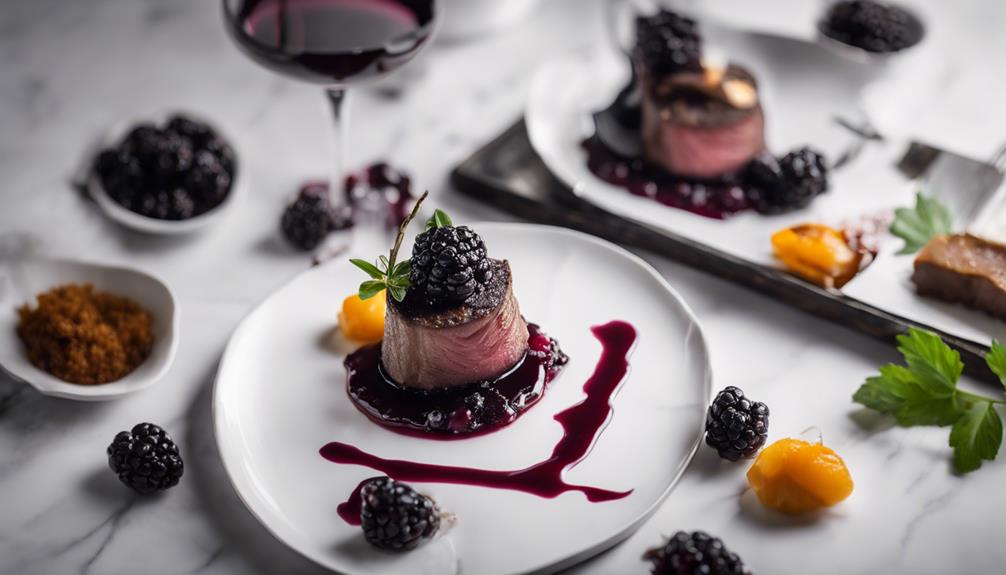
Considering all the delicious flavors and textures you've experienced in this dish, it's clear that Sous Vide Venison with Blackberry Compote is a remarkable culinary adventure. The precision of the sous vide method guarantees that the venison is cooked to perfection, tender and juicy, while still retaining all its natural flavors. The slow cooking process allows the meat to reach an ideal doneness, creating a melt-in-your-mouth experience that's hard to achieve with traditional cooking methods.
Pairing the venison with the sweet and tangy blackberry compote adds a delightful contrast of flavors. The richness of the meat is beautifully complemented by the bright and fruity notes of the compote, creating a well-balanced dish that's sure to impress your taste buds. The burst of blackberry flavor with each bite of venison elevates the dish to a whole new level of sophistication.
Frequently Asked Questions
Can I Substitute Blackberries With Other Fruits in the Compote?
Yes, you can substitute blackberries with other fruits in the compote. Consider using raspberries, blueberries, or even strawberries for a different flavor profile. Experiment with your favorite fruits to find the perfect complement to your dish.
How Can I Adjust the Cooking Time for Rare Venison?
To adjust the cooking time for rare venison, decrease the sous vide time by 30-60 minutes. Keep the temperature the same for a tender and juicy result. Check the doneness with a meat thermometer for precision. Enjoy your perfectly cooked venison!
What Are Some Suggested Wine Pairings for Venison Dishes?
When pairing wine with venison, opt for a robust red like Cabernet Sauvignon or Syrah. Their bold flavors complement the rich taste of venison. Remember to serve the wine slightly below room temperature for the best experience.
Is It Necessary to Rest the Venison Medallions Before Serving?
Yes, it's important to rest the venison medallions before serving. This allows the juices to redistribute, ensuring a more tender and flavorful bite. Give it a few minutes, and you'll be rewarded with a delightful dish.
Can I Use the Same Marinade for Other Types of Meat?
Yes, you can use the same marinade for other types of meat. Just make sure it complements the flavors of the specific meat you're marinating. Experiment with different meats to see which combinations work best for your taste preferences.
Conclusion
To sum up, sous vide venison with blackberry compote is a delectable dish that combines the rich flavors of venison with the sweet and tangy notes of blackberry.
By marinating the venison medallions and searing them to perfection, you can create a gourmet meal that's sure to impress your guests.
Whether you're a fan of French cuisine or simply enjoy experimenting with new flavors, this venison dish is a must-try for any culinary enthusiast.
